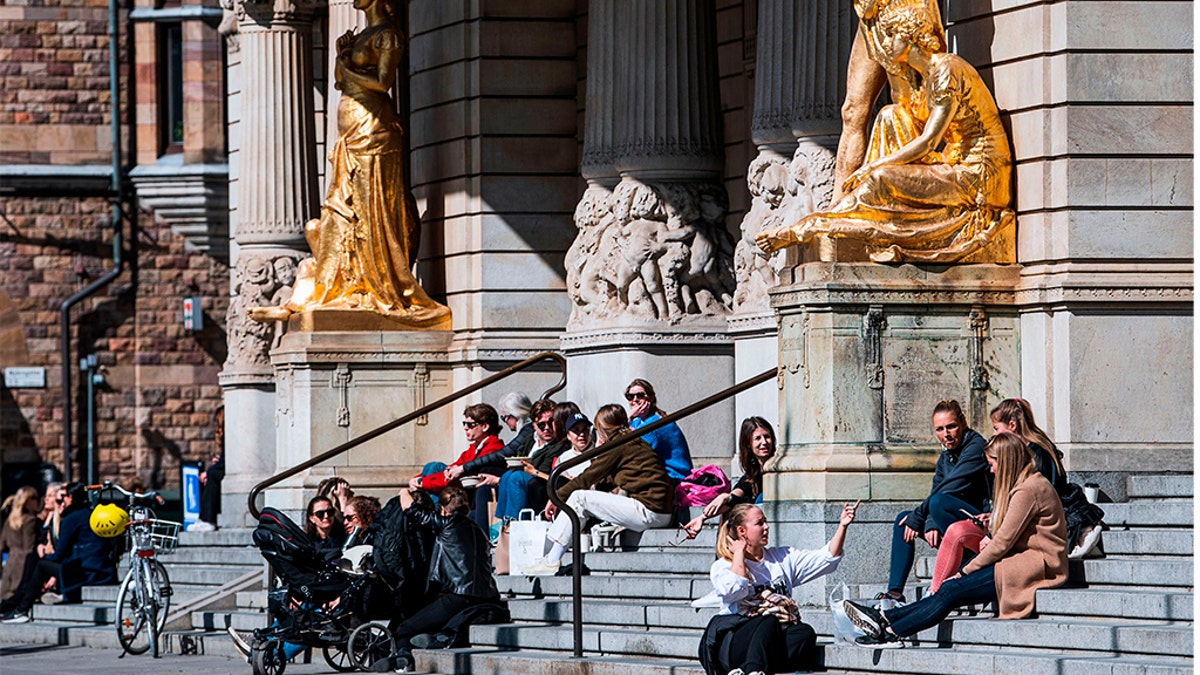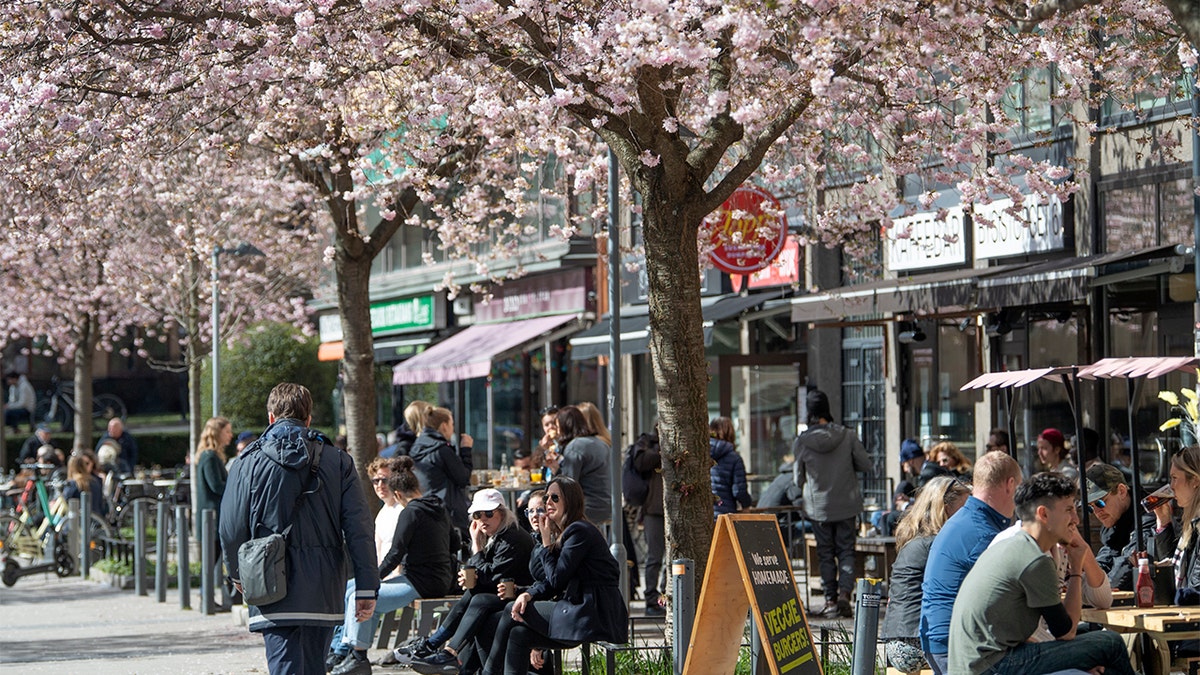What US can learn from Sweden's handling of COVID pandemic
Former New York Times reporter Alex Berenson, author of 'Unreported Truths about COVID-19 and Lockdowns,' and Phil Kerpen, president of the Committee to Unleash Prosperity, join Laura Ingraham with insight.
As much of the world sputtered to a standstill as the novel coronavirus took hold in early Spring, Sweden controversially adopted a different approach in a bid to balance the health crisis with salvaging its economy.
The country's government "departed from the prevailing wisdom" and did not impose widespread lockdowns, did not close schools and restaurants and did not restrict people's movements, Doug Badger, a visiting fellow at The Heritage Foundation, told Fox News.
"But they generally relied on people to take reasonable precautions against spreading the contagion,” Badger continued. “Although its detractors note that Sweden’s COVID-19 death rate is higher than that of its Nordic neighbors (Norway and Denmark), it has fewer deaths per million population than many Western countries that imposed lockdowns, including the U.S., Belgium, Spain, UK, and Italy.”
Moreover, infectious disease expert Kim Sneppen, from the Niels Bohr Institute in Copenhagen, last month went so far as declare the pandemic as almost over – essentially it was “running out of steam” – with a declining death rate, even as its neighbors’ numbers rise and brace for the onslaught of the freeze and flu season.
While off to a dismal start, Sweden recorded the most coronavirus fatalities per capita in Europe, but cases fell from a high of 1,698 in June to around 200 daily by early September.

People sit and enjoy the spring weather outside the Royal Dramatic Theatre in Stockholm on April 15, 2020, during the coronavirus COVID-19 pandemic. (Photo by Jonathan NACKSTRAND / AFP) (Photo by JONATHAN NACKSTRAND/AFP via Getty Images)
As of Monday, Sweden – with a population of 10.2 million – had logged 5,918 coronavirus deaths. Meanwhile, France, with a population of 67 million, has documented 33,477 and Spain has confirmed 33, 775 fatalities with a population of 46.9 million.
Other Scandinavian countries such as Norway fared far lower than Sweden with 680 deaths in its 5.8 million population. But what observers emphasize is that Sweden, while imperfect, has not decimated businesses, education, and livelihoods in its bid to stop the spread.
The government’s approach also centered on empowering its citizens to adopt sensible practices to evade the superspreader, issuing advice – as opposed to decrees – on issues such as social distancing and limiting mass gatherings. Schools never fully closed, staying open for those under the age of 16, and gyms, bars, and restaurants remained open.
According to data from Stockholm, more than 80% of the 10 million people have obeyed the guidance – frequent handwashing, a reduction of activities in crowded spaces, and avoided hand-shaking. Michael Urban, a senior lecturer at the University of New Haven School of Health Sciences, underscored that the Swedish model has fared better than other countries given its cultural approach to life and healthcare in general.
“They have not been perfect by any means with outbreak and periods of high rates of infection just as other countries, but they have been proportionately lower in general,” he said. “(But) socially, Swedish culture as a whole has one of the strongest cultures around social responsibility, which means they work to care not only for themselves but for all those around them. The Swedish are poised to win in the long term if they do not reach social fatigue.”

People take a stroll at Norr Mälarstrand street in Stockholm, Sweden, on April 19, 2020, amid the new coronavirus COVID-19 pandemic. (Photo by Fredrik SANDBERG / TT News Agency / AFP) / Sweden OUT (Photo by FREDRIK SANDBERG/TT News Agency/AFP via Getty Images)
Attila Hertelendy, a U.S.-based expert in biomedicine and emergency management, concurred that the country would “ultimately fare well” in the long run, “especially when it comes to mental health issues since they did not have a formal lockdown.”
Statistics from the European Union, published this month, pointed to an infection rate of roughly 38 cases per 100,000 people. In the U.K. and Spain, which have far more stringent measures in place, it is 87 and 320, respectively.
Public health officials have noted that Sweden has not clocked a jump in coronavirus hospitalizations but that the Swedish theory centered on the tenants of “herd immunity” has not yet actualized. Herd immunity, which generally works in conjunction with a vaccine, is reaching a point in a contagion when more than 60% of the population has been exposed to – and subsequently immune – to the disease, and the transmission rate sharply falters.
Yet government data shows that only around 15% of those in the capital Stockholm have tested positive for antibodies.
“Much has been written about the ‘Swedish model,’ although it’s more of a general approach than a formal model. Overall, the results are mixed,” noted Randall Bolten, UC Berkeley finance professor and author of “Painting with Numbers.” “The social and cultural shock of the pandemic has certainly been mitigated in Sweden, and that may prove valuable in the coming months and years.”
However, the Swedish model remains starkly contentious, and critics of the approach have stressed that the country does not test as rampantly as many other nations, indicating their numbers could be much higher than Stockholm suggests. It has also attracted steep condemnation from front-line healthcare professionals who bemoan that they have not been adequately compensated for their grueling work, with nurses typically earning a third of that of teachers and many planning to step out of the profession altogether amid its time of need.

FILE - In this Wednesday, April 8, 2020 file photo people chat and drink outside a bar in Stockholm, Sweden. Sweden is pursuing relatively liberal policies to fight the coronavirus pandemic, even though there has been a sharp spike in deaths. (AP Photo/Andres Kudacki, File)
Meanwhile, Sweden's economy, despite the early endeavor to keep it pumping, has still suffered. Bloomberg Economics reported that discussions for 2.8 million private-sector jobs fell apart in September, and inflation has slumped to .5%, a trend that has raised questions about long-term recovery.
Nonetheless, other infectious disease experts have also been quick to point out that Sweden may be enduring better than most given that more than half the Nordic nation’s households are individually occupied.
Since the first coronavirus was first detected in the Chinese city of Wuhan, household transmission has been deemed a significant contributor to the disease’s spread into communities. Sweden also has a smaller number of multigenerational households that most of Europe and the lowest median household size in the region: roughly 2.2 people in one dwelling.
Household sizes in Sweden are also typically roomier than other nations where the virus has swelled – including Brazil, Russia, and Mexico, which have one room per person compared to Sweden’s 1.7 per person. Reports in early May indicated that Somali immigrants were among the most impacted by the coronavirus in Sweden. Perhaps not coincidentally, many still live in multigenerational and more cramped residences.
In contrast to the U.K. and the U.S., Sweden’s cities, on average, are also less in density.
However, it remains to be seen how Sweden will hold up with winter on the horizon – and Stockholm has admitted to a mild uptick over the past few weeks, prompting a re-issuance of guidance that came into place Monday. The majority of the new infections, according to Sweden’s top epidemiologist Anders Tegnell, are people in the 20-50 age demographic.
The new recommendations entail wearing a mask in public places, avoid public transport, populous indoor places, and unnecessary travel, and limit physical contact with those outside the family circle. By comparison, France is fighting a sudden surge – around 12,000 new cases daily – and is refusing to rule out another full-scale shutdown.
CORONAVIRUS RELIEF FUNDS FOR NURSING HOMES DRY UP, RAISING FEARS FOR ELDERLY, VULNERABLE
But much like the United States, of which more than half the deaths in most states stemmed from nursing homes and eldercare facilities, from the very beginning in Sweden, these places were the source of almost half of all the coronavirus deaths.
A unified ban on visits was put into place and effective in curbing the number of cases, but offensive rather than defensive management plans and policies were also set-in-motion to get the situation under control. Sweden re-opened its doors to visitors on October 1, and to-date, Tegnell has maintained that there is no data that suggests the country’s mild rise is a result of that.
“Sweden’s greatest failure, as with most countries, including our own, was in failing to protect nursing home residents, people who do not benefit from widespread lockdowns. Few countries – Taiwan and South Korea among them – have successfully suppressed the pandemic,” Badger explained. “But in terms of containing its bad effects without imposing economic hardship on its people, Sweden should be viewed as at least a qualified success when compared to the U.S. and many European nations.”
But as the pandemic continues to rise and fall in different pockets worldwide, some say the jury is still out as to whether the Swedish undertaking could ultimately backfire.

People sit outside in the sun in central Stockholm Saturday April 11, 2020. Swedish authorities have advised the public to practice social distancing because of the coronavirus pandemic, but still allow a large amount of personal freedom, unlike most other European countries. The new coronavirus causes mild or moderate symptoms for most people, but for some, especially older adults and people with existing health problems, it can cause more severe illness or death. (Anders Wiklund/TT via AP)
Even from a business purview, some are cautioning that the Swedish template would be a drastic fit for the far larger United States.
“I don’t believe the U.S. should adopt this approach, strictly because of our sheer size compared with Sweden,” said Ken Mahoney, president of the Wall Street-based Mahoney Asset Management. “Potentially, smaller and less populated E.U. countries could take on elements of their model but having strict restrictions around care homes and people in the elder community is vital as we know there is a higher chance of fatality with this group.”
Yet others contend that there are crucial lessons to be learned.
“A growing body of epidemiologists and public health experts have come to appreciate the limited utility of lockdowns and the harm they do to overall public health and well-being. Like Sweden, governments will increasingly rely on the good sense of their people to avoid behaviors that fuel the pandemic,” Badger added. “But the course of the pandemic is impossible to predict. Sweden has seen an uptick in cases, but nothing like what the U.S. and many of Sweden’s European neighbors are experiencing.”





















